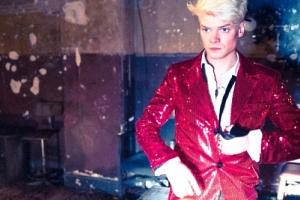Review of The Pitchfork Disney by Philip Ridley at Shoreditch Town Hall
It's commendable of director Jamie Lloyd to take a step back from the commercial excesses of the West End following numerous seasons at the Trafalgar Studios and into the almost site-specific vibe of Shoreditch Town Hall. Presenting two Philip Ridley plays in succession, the first production is a revival of the landmark 1991 dream-come-nightmare The Pitchfork Disney.
A proponent of what critic Aleks Sierz rightly or wrongly labelled 'in-yer-face-theatre' Lloyd's production is about as 'in-yer-face' as it can get. Played in a long traverse with audience sat on a rag and bone collection of footstools, drawers and battered sofas you're instantly immersed in an underground disturbing world from which there's little escape or respite for the intense and deeply disturbing ninety minutes. As the childlike stories of terror and fear unfold you remain immersed in this claustrophobic limbo never quite sure what's occurring beyond the four crumbling walls which quickly becomes this production's strongest virtue - think Pinter for the Shoreditch set.
Presley and Haley are two adults who live alone in East London, surviving on a diet of chocolate and broken dreams. Having been abandoned or 'lost' by their parents a decade ago, they neuter themselves and their feelings through a combination of medicine and drugs which keeps them balancing just about on the edge of sanity and consciousness. As Presley sees a sick man from the window he invites danger into their agoraphobic world in the form of cockroach eating showman Cosmo Disney who appears to be a polished and pretty professional Bush-Tucker Trial performer.
Maintaining atmosphere has always been one of Lloyd's strongest skills and whilst his more recent efforts have relied on broad brush strokes in his directing, such as in the case of Doctor Faustus at the Duke of York's which was a matter of style over substance, it's refreshing to see a finer level of detail and focus on the acting and the text itself that rewards the audience for their committed attention. Ridley's text consists of a number of long monologues told in quasi-dreamlike states that ooze symbolism and can be read in multiple different ways, and have been interpreted throughout time to reflect the context of the world outside. In this setting however these felt intimate and confessional thanks to the bunker-like environment where you remain constantly aware of your lack of escape, from the frosted window to the bolted doors, meaning your focus somehow keeps them in the world of the play itself.
There is nowhere to hide in Soutra Gilmour's punishingly realistic set which allows the acting to always be first rate and inches from your face. George Blagden barely leaves the stage switching between the different tones of the piece with ease and maintaining the perfect level of loss and frustration that's balanced by the bravado of Tom Rhys Harries' polished and intricate Cosmo whose trite smile alone suggests danger beneath the surface. It's their dialogue that feels the strongest, and whilst it may not always be coherent or easy to follow, their relationship is finely textured and well positioned.
It's menacing, intimidating and ultimately quite disturbing. Not for the faint of heart it pushes the boundaries of what it means to be an audience member; there are points where people recoil, avert their eyes and almost step in to intervene. "You know why the ghost train is so popular? Because there are no ghosts" Cosmo proclaims, discussing the human need to be shocked, scared and pushed to the limit. Far from a traditionally enjoyable evening at the theatre it'll keep you alert and on the edge of your seat, or in this case, edge of your Ottoman.
Originally published on
